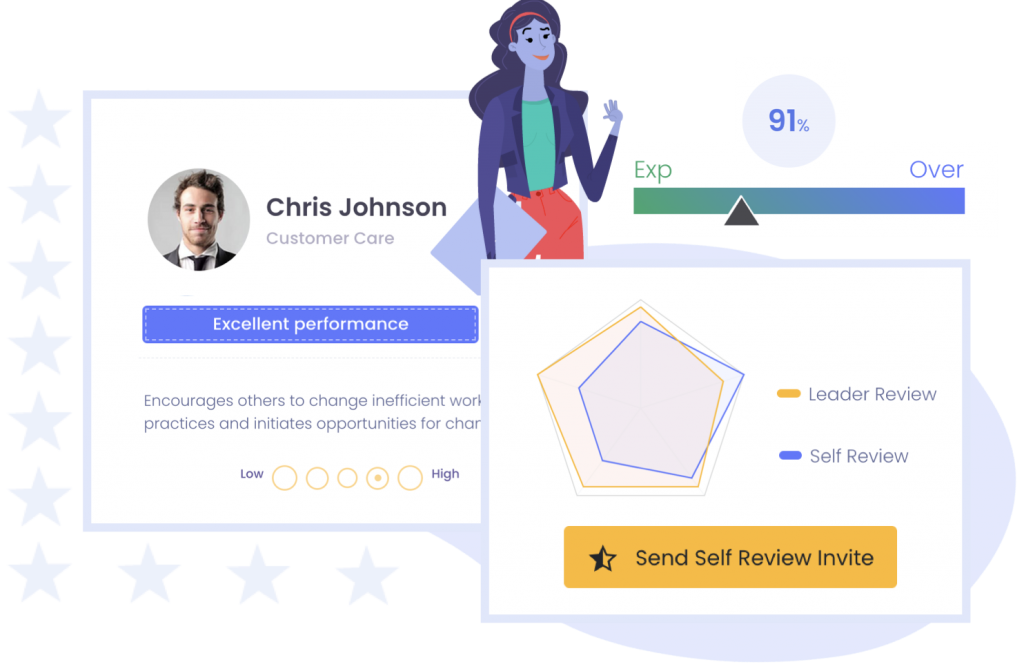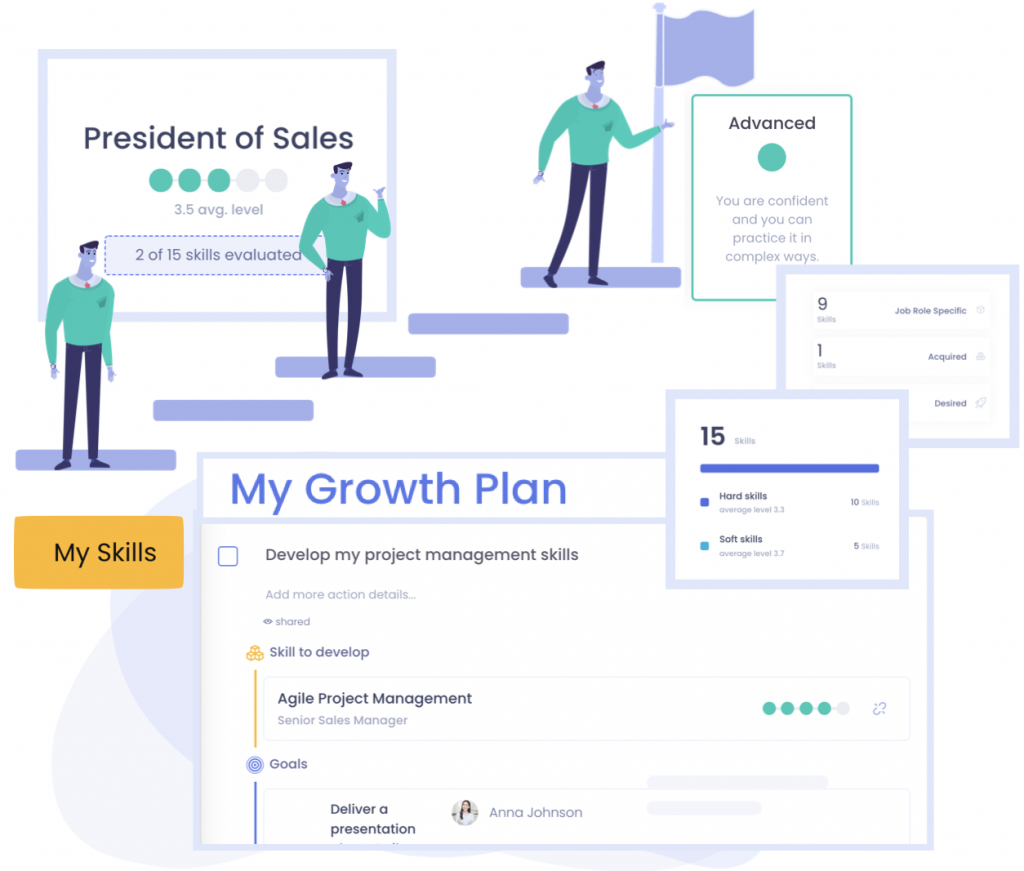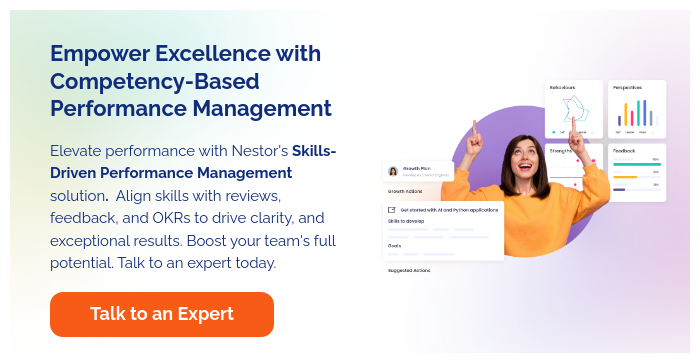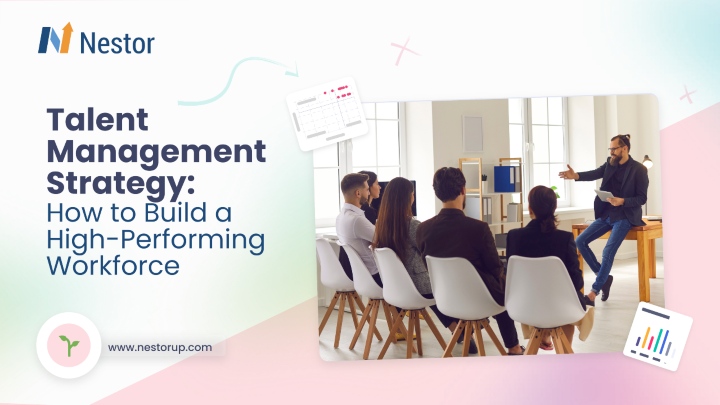Competency-Based Performance Management: Benefits and How to Implement It
10 min read

Now more than ever, organizations face increasing pressure to maximize employee performance and productivity — all while simultaneously looking at L&D and professional development as answers to the current talent shortages and skill gaps.
And since traditional systems often fall short in addressing these complex demands, approaches like competency-based performance management are emerging as a possible answer. This framework shifts the focus from annual reviews to an ongoing process focused on future employee development through nurturing specific competencies and behaviors, which are essential for success in a given role.
Let’s jump right in and find out the secrets behind competency-based performance management and the steps necessary for adopting this approach.
What is competency-based performance management?
Competency-based performance management is an ongoing process that seeks to drive, evaluate, and improve employee performance by focusing on specific behaviors, attitudes, and (personal) attributes — or what we refer to as competencies.
This approach to performance management drives ongoing learning and nurtures professional and career growth — ensuring that people can develop and acquire the right competencies to perform at their best or prepare for a new role.
Competency-based performance management vs traditional performance management
Unlike traditional performance management systems, the competency-based approach doesn’t focus solely on past outcomes, emphasizing instead the behaviors and processes that enable workers to perform well and achieve their goals.
In other words, competency-based performance management prioritizes the ‘how’ behind specific results just as much (or even more than) the ‘what’.
Thanks to this focus on how goals are accomplished, the competency-based approach is future-oriented — how to improve those competencies to perform even better — instead of past-oriented, like traditional models, which look mainly at what was achieved.
Another important difference is that the competency-based model relies on frequent check-ins, one-on-one meetings, and feedback sessions, while the traditional approach is mostly about annual appraisals.
Decide On Objectives vs. Goals and Behaviors
An important step you should decide upon is whether to focus the discussion around clearly defined behaviors solely or around these behaviors and their connection to operational goals.
At Nestor, we provide a holistic approach to performance and talent management through regular check-ins, goal management, competency-based performance reviews, and personalized development plans and opportunities focused on continuous employee growth.
Benefits of adopting a competency-based performance management system
Significantly improves performance review outcomes
The reality is many employees dread the one-on-one annual performance appraisal. It’s simply outdated and fails to deliver the support needed to encourage and promote growth in the modern work environment. And it’s susceptible to subjective assessments and things like the recency bias.
With competency-based performance management, you’ll have a solid framework for evaluating and managing the performance of your employees — and they, in turn, will know exactly what’s expected from them and how they match up against those expectations.
Moreover, by focusing the discussion on specific competencies and behaviors employees exhibit, you will help minimize the negative feelings that can occur when discussing weaknesses.
Streamlines the succession planning process
Succession planning is a critical but often overlooked aspect of strategic workforce planning. As a direct result, organizations end up losing key expertise and experience due to retirements or unexpected departures.
The competency-based approach helps you identify potential leaders early on, who can then be (with their agreement) enrolled into leadership development programs — especially job shadowing and mentoring — so that you can nurture a strong pipeline of top talent who are ready to replace the most experienced people inside the company.
Clarifies expectations and performance requirements
Confusion around performance expectations or job requirements in general can lead to different undesirable situations, including unhappy or unengaged employees and unproductive or surprising discussions and opinion differences during performance reviews.
Luckily, these can be easily avoided with a competency-based performance management model, since both competencies and the competency profile of each job role are transparent to managers and employees alike, ensuring everyone knows what’s expected from them.
Makes professional and career development transparent
The transparency mentioned in the previous point also has another highly beneficial effect — every person inside the company knows what they need to do to either grow in their current position or make the next move.
And this doesn’t need to be limited to traditional promotions or vertical moves. In fact, it opens the door to more dynamic and flexible career paths and moves, which any employee can make as long as their profile matches the competency profile of the new role.
How to create and implement a competency-based performance management system
1. Establish the type of competencies within your organization
The first step is defining the various types of competencies, which can include:
- Core competencies: These usually apply to all roles and are aligned with the larger organizational identity, vision, and goals. They help the company stand out. For example, excellent customer service is one of the core competencies of the tech-giant Apple.
- Competencies specific to business units: Strategic planning is a great competency example for HR and Marketing departments.
- Competencies specific to job groups: Attention to detail or error-free verification is critical for accountants.
- Competencies specific to a job: Leadership is a good example for team leads, supervisors, or department heads.
2. Map competencies to each job role
Mapping competencies to individual job roles is an integral part of creating an organization-wide competency framework. When assigning competencies, it’s important to differentiate between core or functional competencies (the must-have for each role) and technical competencies.
Keeping competencies and the competency profile of each role up-to-date is critical because both can evolve over time. This is why we recommend being aware of the competency requirements in your industry and adjusting accordingly.
Once competencies are defined, you should also include them in job descriptions, which, in addition to performance management and expectations, will also help with transparency over various career paths and internal mobility opportunities.
3. Conduct competency-based performance reviews
Once your competency framework is in place and everyone within the company is aware of it, you can start conducting performance reviews that are based on competencies. This shift will likely require additional training and support for your managers.
Competency-based performance appraisal
In a competency-based performance management system, managers use appraisals to evaluate both the current level and the consistent demonstration of each competency, usually through a grading or rating system.
In this type of review, employees are assessed against a set of pre-defined competencies for their particular role or what’s expected from them in that role. Employees also have the opportunity to assess themselves and, at the end of the process, have conversations with their managers, compare the two perspectives, and focus on future growth actions.

Competency-based 360 feedback
In competency-based performance management, anonymous 360-degree or multi-source feedback is an excellent opportunity to better understand how someone performed over a certain period or as part of a team.
The feedback can come from multiple sources — interns, juniors, peers, direct reports, supervisors — and offers a more holistic image of a person’s competencies and how well they have demonstrated those competencies while performing day-to-day tasks.
These insights will highlight both strong and lower-rated competencies, revealing hidden strengths, areas for improvement, and also different perspectives (self, manager, peers) on how an employee uses their competencies to meet performance expectations.

4. Develop growth plans and assign L&D opportunities for each competency
Once competency gaps are identified, the managers can sit together with each team member and establish growth plans for improving each competency. Together, they will decide what steps are necessary to further advance individual competencies and what areas of improvement will be given priority.
For example, on the Nestor platform, this type of plan consists of outlining clear goals, specifying growth actions closely linked to the skills and competencies you need to master, and establishing the methods used to track and evaluate progress over time.

In the example below, you can see Anna, our made-up employee, seeking to improve her collaboration competency to level 5: advanced, making progress from her last evaluation, when this competency was ranked to 4: proficient level. In Nestor, we use a rating system with 5 levels: aware of, beginner, familiar with, proficient, and advanced.
Anna’s goal is to become even more efficient in her team and, in this particular case, seeking to participate in a project is the growth action chosen to further develop her collaboration competency.

5. Monitor and evaluate the impact of the new competency-based performance management system
Monitoring the impact and effectiveness of the new competency-based approach should happen regularly.
It’s not only about having and maintaining detailed and diligent documentation, but rather identifying what’s working and what isn’t — and ensuring that both competencies and the competency-based system itself are still aligned with the larger business objectives.
The most relevant feedback about the new system will come from managers and employees, who will be impacted the most by this transition. It’s important to listen to their pain points and suggestions and leverage anonymous feedback forms to gather honest and useful opinions. You can then make revisions as required.
How Nestor can help you transition to a competency-based performance management system
Competency-based performance management represents a dynamic and future-oriented framework that enhances clarity, fairness, and transparency in evaluating employee performance — thus enabling and nurturing growth and development.
And since Nestor is a skills- and competencies-first platform, our integrated solutions are uniquely positioned to help organizations unlock the Power of Skills and Competencies to drive workforce agility, high performance, and continuous growth.
With Nestor, you’ll be able to run competency-based performance reviews and understand also how work is done not only what it is achieved, pinpointing specific areas where employees need to further develop their capabilities.
Schedule a free demo session and let our consultants walk you through the whole process of defining competencies, running competency-based performance reviews or 360 feedback, and finally closing the loop with customized employee development plans.









